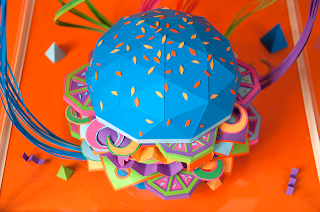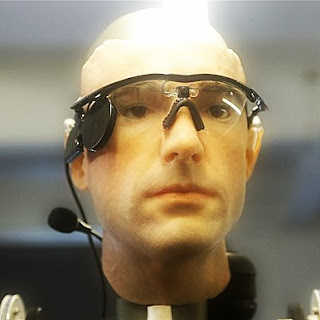Europium is chemical element 63... So it's the perfect name for this SCIENCE blog written in English by young scientists in French Département 63 (Puy-de-Dôme)!
23 November 2013
2 November 2013
26 October 2013
Quantum leap...
Google, NASA and D-Wave recently
released a video (see it by clicking on the link above!) explaining the features of their new common project: a Quantum
Artificial Intelligence lab which will aim to create one of the first commercial
quantum computers.
So what is a quantum computer? Quantum computers
are computation devices that make direct use of quantum-mechanical phenomena,
such as superposition, entanglement, multi-verse or tunnelling (all mentioned in
the video) to perform operations on data. The main difference with “normal”
(digital) computation is the use of qubits instead of bits. Whereas a bit (i.e. a
binary digit: a digit of the binary numeral system and the basic unit of
information in computing) can only have one of two values: either a 0 or a 1, a
qubit can actually exist in superposition of the two values, having 0 and 1 at
the same time... This new type of computer will allow us to answer many questions
that can't be answered with current computers. Beautiful, but how will they achieve that?
Even if it is still too soon
for normal people like us to understand the power of these computers, the key
might be optimization. As they explain in the video, optimization is one of the
major obstacles in computer science nowadays, since even with today's mega
computers there are still some problems that we aren't able to solve because of
their extreme demands in calculation. For instance, they give the example of
the travelling salesman who wants to know which would be the shortest and
fastest route to visit a particular number of cities. There are so many
possible routes depending on so many factors (for example, 479 001 600
different combinations within 12 cities), that it would actually take hundreds
of years to calculate all of them if we work with a considerable number of
cities (above 20)…
The main aim of the project
is to improve machine learning, i.e. artificial intelligence, so we can develop more efficient processors that could be used in radars, aircraft
systems, smartphones, etc. An example of this “intelligence” would be one of
the latest features Google has been working on: infallible facial recognition, which is ostensibly
only a human capability. Since it is Google which is behind this project, we can
be very optimistic about the progress of the research as the American giant is cutting edge.
It is awesome that humans
have been actually able to create something that may answer the questions that
we cannot answer by ourselves. It might seem like pure fantasy now, but with
quantum processors we will eventually do some incredible things, like run
computer-simulated universes that are indistinguishable from our own real
universe, complete with simulated minds…
Article by Jesús Bujalance
19 October 2013
6 October 2013
6 August 2013
2 August 2013
8 July 2013
3 July 2013
29 May 2013
10 May 2013
29 April 2013
What will my job be? Sports physiotherapist!
Why am I doing a Sciences
Baccalaureate? What do I really want to do as a job later (this is a question
that has nagged me for years)? I have finally found the answer: physiotherapist.
Physiotherapists treat
patients with physical difficulties resulting from illness, injury, disability
or ageing. They treat people of all ages, stroke patients, and people with
sports injuries.
Physiotherapists work with
patients to identify and improve their movement and function. They help promote
their patients' health and wellbeing, and assist the rehabilitation process by
developing and restoring body systems, in particular the neuromuscular,
musculoskeletal, cardiovascular and respiratory systems. They devise and review
treatment programs, comprising manual therapy, movement, therapeutic exercise
and the application of technological equipment (ultrasound for example).
Physiotherapists also provide advice on how to avoid injuries.
I have scoliosis. I was
prescribed a three-month physiotherapy treatment, but I have become a long-term
physiotherapy patient for this ailment. The healing consists in physical
manipulation in order to make my backbone straight again. Right now, I have tendinitis
in the biceps tendon of my left arm. For this, my physiotherapist uses
ultrasound and electro-stimulation machines. This equipment is often used for
sportsmen who are on a rigorous training program. Electro-stimulation is used
to stimulate blood flow in the weakened tendon. Thanks to this machine, I have
managed to continue training (I’m a swimmer), though there is a risk of weakening
of my tendon.
This job really interests me
because first of all I really like studying how the body works; how are muscles
repaired through physiotherapy? How does an ultrasound machine make my tendons
healthy? Those questions arouse my curiosity, and make me want to learn more.
Therapists require good
communication skills to establish and maintain good relationships with patients;
he must listen very carefully to his patients and be able to communicate easily
with him. Ability to listen and be listened to also enables the physiotherapist
to work effectively within a healthcare team. Resourcefulness, compassion and
patience are the other qualities that are essential in this professional
healthcare area.
There are several paths to
choose if you're considering a career in physiotherapy and this really depends
on what type of physiotherapy career you are envisaging. For example, I would
like to specialize in sports injuries. The sports physiotherapist works most
often alone, without medical backup (except in professional clubs). He follows the
sportsmen during competitions, which means he can be away just a few hours but
also for several days, often on weekends. A sports physiotherapist can be employed
by a sports club or a federation (for the Olympic Games for example).
A sports physiotherapist is a
physiotherapist who has (in 80% of cases) completed a specific physiotherapist training
(leading to a “Diplôme d'Etat” certificate). There are various paths to enter
schools which prepare you for the diploma: there is the standard entry exam, but
here is also the “PAES” (i.e. entry after a year of health studies). The entry exam is open to people with a Bachelor’s
degree in Sciences or with an equivalent diploma. There are three exams: one in
Biology, another in Physics and the last in Chemistry. The number of candidates
for the entrance exam is high; most of the time these candidates have one or even
two years of specific training in a private school beforehand.
In public institutions, the
salary of a physiotherapist begins at about 1,500€ a month. In private
institutions, starting salary ranges from 1500€ to 2500€ a month.
If it also your dream job or if
you simply want to know more about becoming a physiotherapist, send me a comment!
Article by Antoine Jourdet
Labels:
What will my job be
27 April 2013
22 April 2013
NASA's Asteroid Initiative and other money-wasting schemes...
NASA plans to capture a small
near-Earth asteroid using a robot and redirect it to a stable orbit in the
Earth-Moon system where astronauts can then explore it to study its composition.
This robot will also search for larger asteroids that might endanger the Earth…
The machine will use current technology
like the Space Launch System and the Orion spacecraft, and technology that is yet
to be developed like high-powered solar electric propulsion.
If this operation succeeds, it will prove
that NASA has the technological mastery to send humans to Mars by 2030 (President
Obama’s wish).
But, how can America afford to send
humans to Mars when government debt is in excess of $17 trillion?!
The American government should focus
on reducing its debt and helping the poor rather than trying to prove its technological
superiority in a mad flight into space (the scientific interest of which
remains to be proven)… What do YOU think? Send us your comments please!
Article by Mathilde & Pierre-Henri
30 March 2013
The icemen cometh...
In February 2012, after
more than two decades of drilling, Russian scientists finally reached the surface of the sub-glacial lake of Vostok, in Antarctica.
They were able to take some fragments in the lake and the scientists returned in the next weeks in order to bring up more study samples. The
water of this lake has not been in contact with the outside world for several
million years! The researchers think they have discovered unknown life forms...
There are other research
projects in the subsoil under the Antarctic ice: an American team
is exploring Whillans Ice Stream, where the Antarctic ice joins the Southern
Ocean, and a British team has been searching Lake Ellsworth, also located under the ice.
Article by Antoine Jourdet
Labels:
In the news
29 March 2013
The science behind the Vatican’s smoke signal explained!
Habemus Papam!
Traditionally, the Vatican produced the different colours by burning wet straw for white and tarry pitch for black smoke. But why did the Vatican stop using this method? Mostly because it was noxious, as burning wet straw is full of sooty carbon particles that can overload the lungs and that are potentially carcinogenic. The decision to use a more reliable method based on chemical products was made during the last conclave in 2005. The Vatican has now revealed what these are. For black, it uses a mixture of potassium, perchlorate, anthracene and sulphur; white comes from potassium chlorate, lactose and the conifer resin called rosin, which is often rubbed on violin bows to increase friction.
Article by Mathilde & Pierre-Henri
Labels:
In the news
23 March 2013
12 March 2013
9 March 2013
8 March 2013
4 March 2013
15 February 2013
What's the point of 3D printers? By Mathilde, Pierre-Henry and Julien
3D printing technologies creates a three dimensional
object layer by successive layer, until the entire object is complete. Each
3D-printed object begins with a digital Computer Aided Design (CAD) file,
created with a 3D modeling program. To get from this digital file into
instructions that the 3D printer understands software then slices the design
into hundreds or thousands of horizontal layers. The 3D printer reads this
file, and creates each layer exactly to specification. As the layers are
created, they blend together with no hint of the layering visible, resulting in
a three dimensional object.
3D printing has been used by industry for the last 30
years, but consumer and small business-oriented 3D printing is only just taking
off, mostly thanks to the MakerBot and RepRaps. Industrial 3D printers tend to be very large and
very expensive whereas consumer-oriented 3D printers are cheaper, smaller, but
of course slower. Will the 3D
printer for all change the world as we know it? Probably not, but we think it’s
an amazing invention, what about you?
Julien adds:
You have always dreamt of a printer in your kitchen?
Well, you’re mad. But your dream could actually come true! Indeed, recently,
Nasa gave $125,000 to an enterprise in order to develop a 3D food printer. In
fact, it would enable astronauts to have good quality food at last. The idea is
to print the food layer by layer… For example you could “print out” a pizza!
But its creator, Anjan Contractor, sees more than a simple food
provider for astronauts in his device. He actually believes his food printer
will be able to feed all of humanity in order to solve the problem of food
security…Now, let’s just hope the food printers won’t keep
breaking down like the ones we are used to!
Labels:
Massillon
6 February 2013
30 January 2013
Subscribe to:
Comments (Atom)



























